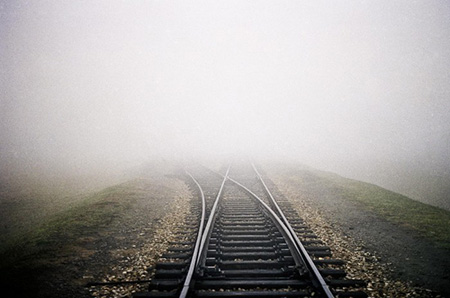
Continuing through November 28 / December 3, 2015
Two exhibitions this month deal with the past, present and future prospects for an area increasingly referred to as “borderlands,” after the recent book discussing the north-south corridor of east central Europe where much of the bloodshed of the 20th century occurred: Poland and Ukraine. Alexander Mouton, an assistant professor at Seattle University, has been traveling and photographing in Poland and Ukraine since 1989. His survey, “Some Time Later … I’m Here: Photographs from Poland & Ukraine” is of more recent work. David Beckley exhibited many of his “Auschwitz” photographs (2003-2009) at the Berliner Kunstsalon in Germany before his current, larger grouping of photographs, collages, and prints at Gallery 110 called “Again?”
Beckley addresses, through digital imagery, photo-alteration and mid-scale color prints the documentary photographic heritage of the Holocaust. Mouton, makes new film, digital and video footage of cities and towns in both countries as they appear today. As Beckley points out, this year is the 70th anniversary of the liberation of Auschwitz and the 75th anniversary of its inception. His “Can I Choose?” is a stacked “group portrait” of seven Polish citizens who hid or helped Jews; and a parallel group of seven Germans who worked at the camp, the latter of whom were executed or committed suicide after World War II.
Much of the appeal of Beckley’s approach is the variety of media he employs from piece to piece. “Window” is a walled-up brick window at Auschwitz-Birkenau. “That Which is Unconscious in Us We are Obliged to Repeat” is a four-by-three-image grid of the infamous railroad track at Auschwitz-Birkenau in the fog. Behind the fog lies the iconic entry guard tower. “Indifference” piles on images of Germans swept up by the Third Reich with overlaid images of two hanging men and an African-American lynching. Merging Nazi crimes with racial murders in the American South is ingenious and compelling. “Auschwitz 2003-2009” and “Birkenau Landscapes” also use a grid. In the former the formal device serves to blur and blend images of graves, poison gas canisters, clothing and other belongings left behind and displayed at the Auschwitz State Museum galleries, converted barracks and guard posts. The latter, all taken in the summer, contrasts idyllic green lawns, forests and fields with the barbed wire fences, railroad tracks and pathways that led to the gas chambers. The biggest work on view, “Collage/Hope,” combines newspaper clippings about the Armenian genocide, homophobic violence and anti-Muslim protests, with anti-Latino signs. The bright color snapshots are juxtaposed with fading black-and-white vintage photos.
Mouton’s “borderlands” convey a more hopeful outlook, at least in the images of people in Polish cities and towns today. Much of the dinginess of the Cold War era has been wiped clean in Poland, but Mouton has an eye for quirky, downtrodden couples and individuals, such as those in the southeast, many of whom are leftovers from the bloated, polluting Soviet-built industrial belt. Warsaw, Kraków, Lódz and Wrocław are represented, not with landmarks or tourist sites, but off-hand views of people in parks, window-shopping and generally enjoying the climate of peace and stability after a century of war and occupation. A former Fulbright fellow, Mouton is undertaking an ongoing documentary project of the “borderlands” areas, including portraits of people who “survived the Nazi invasion, Stalin’s brutal rule and postwar Soviet totalitarianism.”
One never knows what happened in any given locale in Poland and Ukraine. Thus, Mouton’s “Park Benches . . . Warsaw” seems serene, but also recalls how the city re-grew its parks after being flattened by Nazi bombing in 1943 and 1944. “Lódz-Kaliska Railway” is shot from inside a train, echoing the view of many of the victims that were transported on the death trains that passed through and left from Lódz en route to Treblinka to the north and Auschwitz to the south.
Considering that this was the artist’s Seattle gallery debut and that he has works in the Museum of Modern Art, New York, Berlin and elsewhere, it would have been illuminating to have also included earlier black-and-white photographs from his visits closer to the time of the fall of the Berlin Wall. This, and some of his videotapes or even performance art, could have made a better introduction. As they stand, the color prints are a tantalizing glimpse into another artist who, like Beckley, has become obsessed with the circumstances of the post-Holocaust world first, and the post-Communist next. Both were disasters from which Poland and Ukraine are still recovering. Mouton and Beckley make us look and think about the whole spectrum of the history of the “borderlands.”
